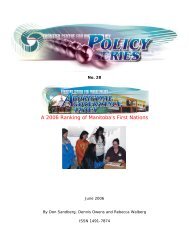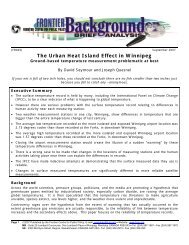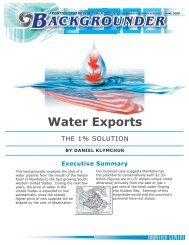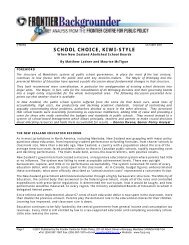The New Paradigm - Federal Reserve Bank of Dallas
Create successful ePaper yourself
Turn your PDF publications into a flip-book with our unique Google optimized e-Paper software.
50<br />
<strong>The</strong> weighted-average assumption used in developing the postretirement benefit obligation<br />
as <strong>of</strong> December 31, 1999, and December 31, 1998, was 7.5 percent and 6.25<br />
percent, respectively.<br />
For measurement purposes, an 8.75 percent annual rate <strong>of</strong> increase in the cost <strong>of</strong> covered<br />
health care benefits was assumed for 2000. Ultimately, the health care cost trend<br />
rate is expected to decrease gradually to 5.5 percent by 2006, and remain at that level<br />
thereafter.<br />
Assumed health care cost trend rates have a significant effect on the amounts reported<br />
for health care plans. A 1 percentage point change in assumed health care cost trend rates<br />
would have the following effects for the year ended December 31, 1999 (in millions):<br />
1 Percentage 1 Percentage<br />
Point Point<br />
Increase Decrease<br />
Effect on aggregate <strong>of</strong> service and interest cost<br />
components <strong>of</strong> net periodic postretirement<br />
benefit cost $ 0.8 $ (0.6)<br />
Effect on accumulated postretirement benefit<br />
obligation 1.7 (1.6)<br />
<strong>The</strong> following is a summary <strong>of</strong> the components <strong>of</strong> net periodic postretirement benefit<br />
cost for the years ended December 31 (in millions):<br />
1999 1998<br />
Service cost—benefits earned during the period $ 1.3 $ 1.4<br />
Interest cost <strong>of</strong> accumulated benefit obligation 2.2 2.7<br />
Amortization <strong>of</strong> prior service cost (1.0) (0.5)<br />
Recognized net actuarial loss 0.3 0.1<br />
Net periodic postretirement benefit cost $ 2.8 $ 3.7<br />
Net periodic postretirement benefit cost is reported as a component <strong>of</strong> “Salaries and other<br />
benefits.”<br />
POSTEMPLOYMENT BENEFITS<br />
<strong>The</strong> <strong>Bank</strong> <strong>of</strong>fers benefits to former or inactive employees. Postemployment benefit costs<br />
are actuarially determined and include the cost <strong>of</strong> medical and dental insurance, survivor<br />
income, and disability benefits. Costs were projected using the same discount rate<br />
and health care trend rates as were used for projecting postretirement costs. <strong>The</strong> accrued<br />
postemployment benefit costs recognized by the <strong>Bank</strong> at December 31, 1999, and<br />
December 31, 1998, were $6 million each year. This cost is included as a component <strong>of</strong><br />
“Accrued benefit cost.” Net periodic postemployment benefit costs included in 1999 and<br />
1998 operating expenses were $1 million each year.<br />
1999 ANNUAL REPORT <strong>Federal</strong> <strong>Reserve</strong> <strong>Bank</strong> <strong>of</strong> <strong>Dallas</strong>

















